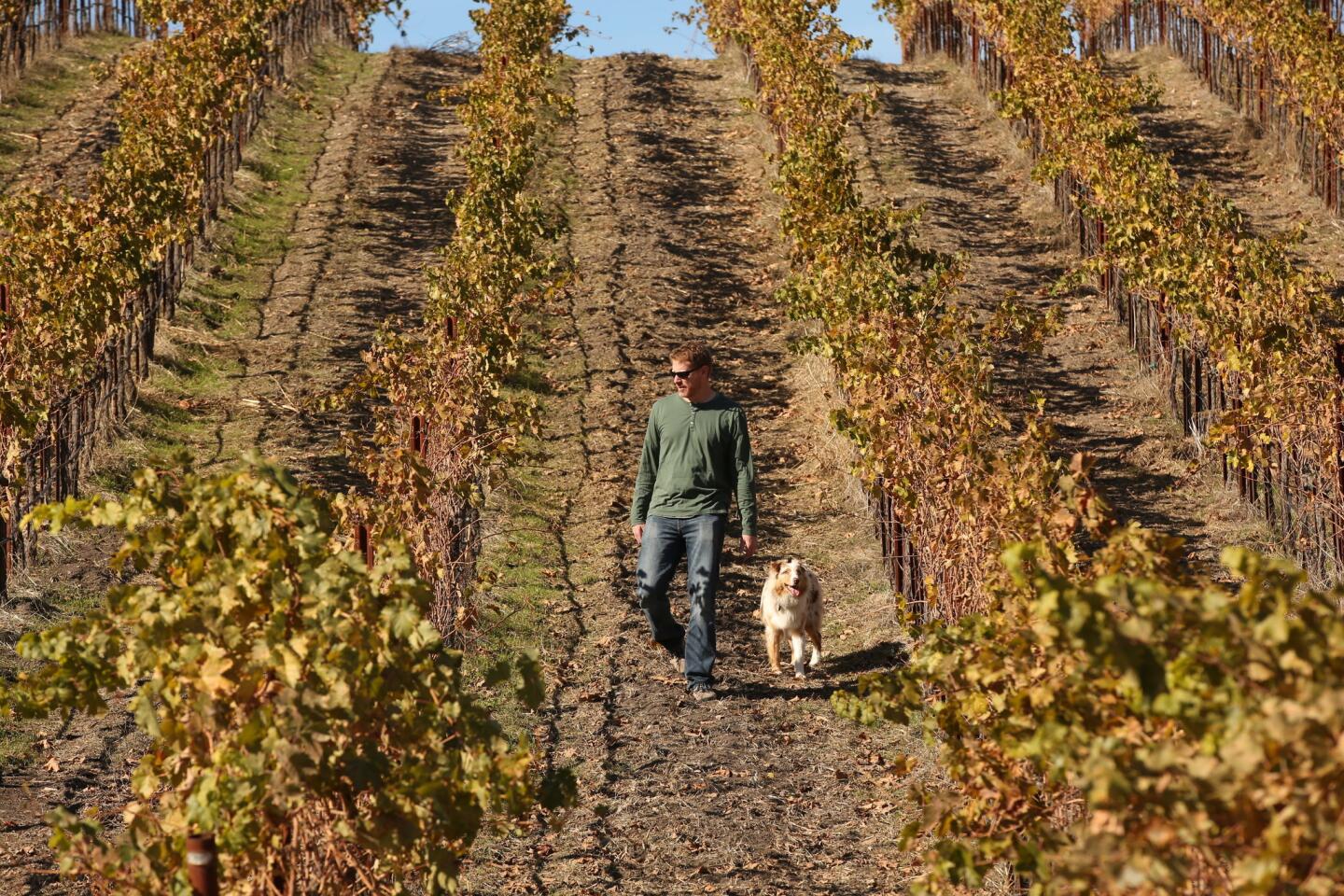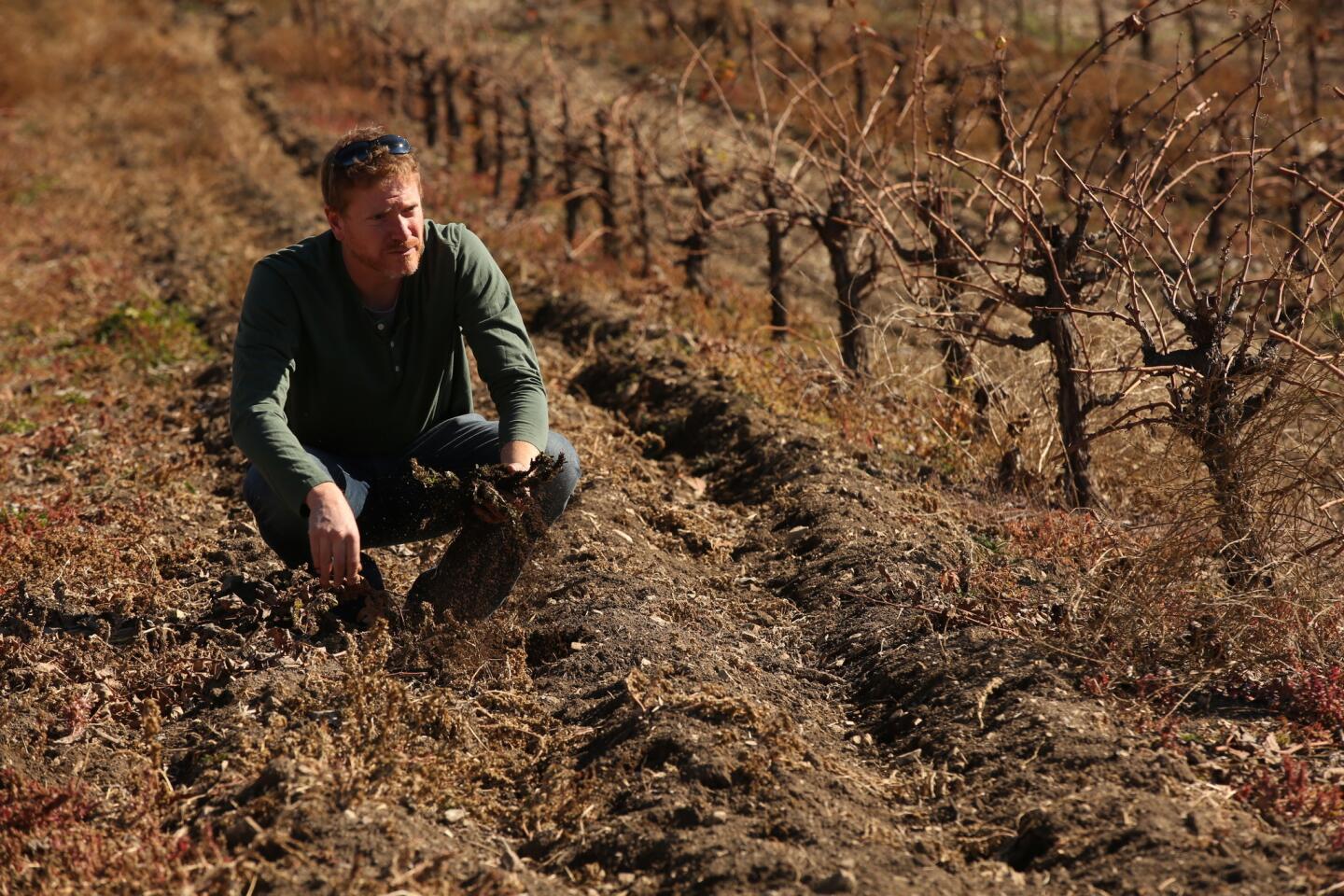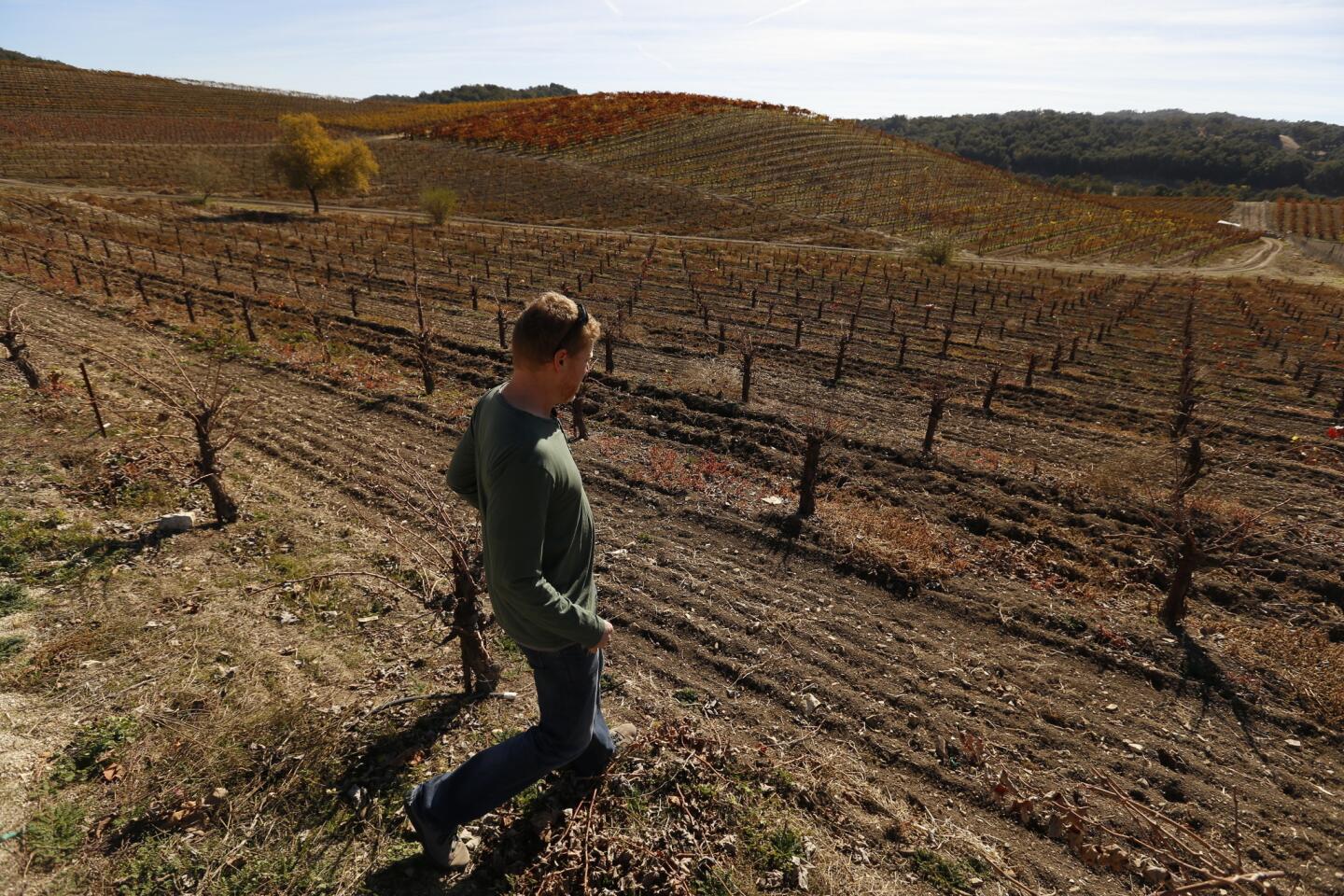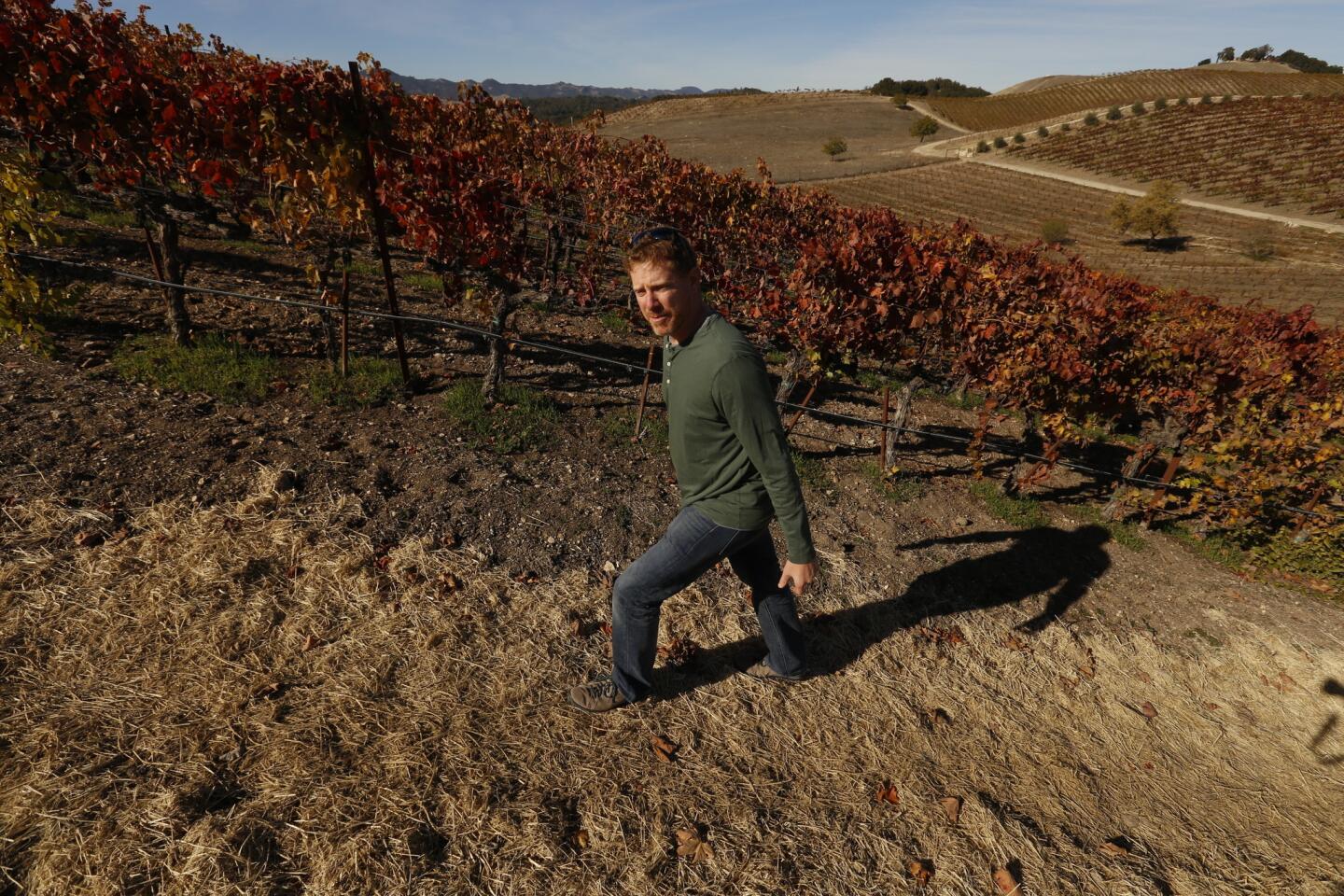El Niño could be a boon or a blow to California vineyards
- Share via
Jason Haas’ plan for El Niño involves oats, sweet peas, vetch, clover, sheep, alpacas, a llama and a couple of donkeys.
It’s not for everyone, the organic viticulturist admits. But it works for his family’s Paso Robles vineyard, where dormant vines have laid bare acre after acre of precious topsoil on steep hillsides.
If all goes well, gentle rains will coax out a lush cover crop to protect from a deluge, and the odd menagerie will slowly nibble it to a nub by spring, when the vines revive.
Water and Power is The Times’ guide to the drought. Sign up to get the free newsletter >>
“We’ve already gotten three small storms that have come through and dumped about half an inch of rain each,” said Haas, partner and general manager of Tablas Creek Vineyards in Paso Robles. “The cover crop is sprouted. That’s going to do a big piece to hold the soil in place.”
Across California’s wine regions, growers are hoping a tenuous cover crop and ample straw will keep their nutrient-rich topsoil in place through what may be the first very wet winter in more than four years.
Atmospheric scientists have said the shift in Pacific Ocean currents that sparks the global weather phenomenon known as El Niño will bring a greater-than-even chance of above-normal rain across the center of the state. That makes the topsoil on steep hillside vineyards around Paso Robles more vulnerable than the more moderately sloped acreage in Napa and Sonoma, where growers are accustomed to higher rainfall.
Not far from Haas’ farm, relative newcomer Jason Yeager is staring down what could be the first wet winter his vines have seen since he planted them five years ago. But he grew up in a wine family in Napa, where putting in a cover crop is standard operating procedure.
“Down here it’s starting to become that way, and we’re trying to get the word out to other growers that may not do that sort of thing to spend a little money and put a little something in there, because if they don’t, it’s going to be a problem,” said Yeager, director of vineyards at Niner Wine Estates in Paso Robles.
“As farmers, we’re all interested in keeping our soil right in place. That’s how we make a living,” said Garrett Buckland of Premiere Viticultural Services, a consulting company in Napa. “It doesn’t do us any good if it’s out in the bay somewhere.”
The Central Coast had a dress rehearsal in July, when the remnants of a Pacific hurricane dumped 3.55 inches of rain around Paso Robles. “Everything was bare,” Yeager said. “You’re never expecting that kind of rain in July here because it just never happens. I had quite a mess to clean up here.”
One walnut grower lost tons of topsoil from a recently tilled property west of the city.
“You can lose hundreds of tons of topsoil from a downpour like that,” said grower and vintner Matt Merrill, general manager of Mesa Vineyard Management Inc. in Templeton, which oversees about 12,000 acres of vineyards in the Central Coast region.
Properties he manages are putting down hay and a cover crop, clearing ditches and drains and taking other measures to prepare, Merrill said.
“A lot of the vineyards we manage now have gone to having a permanent cover crop, so you don’t go through and disc it up and disturb the soil,” Merrill said. “It seems like, industrywide, people are prepared and expecting it — and hoping that it does come true, that there’s all this rain coming. “
But frequent rains and torrential downpours could boost the cost of next year’s vintages as much as 20%, said Jennifer Putnam, executive director of Napa Valley Grapegrowers. More crews will make more passes through fields when it rains, keeping drainage ditches clear and trying to keep runoff from creating new channels. Other work will be postponed, Putnam said. Growers hesitate to leave pruning wounds open to water, which can spread fungal spores that cause trunk diseases.
“It’s going to be really tricky workforce management this year — and very expensive,” Putnam said.
“You have more people out there looking at things. You have more straw, more seed,” said Paul Goldberg, vineyard manager for Bettinelli Vineyards in Napa. “All those things drive up the cost.”
About a quarter of the winery’s 500 acres lie on slopes of 5% to 30%, he said.
Duff Bevill, who has managed vineyards in nearby Sonoma County since the 1970s, takes both the cost and the rains in stride. “Some years you’re under; some years you’re over,” he said.
The right rain at the right time is crucial. In February 1998, a massive El Niño storm inundated low-lying vineyards in Sonoma and Napa counties, but because the vines were dormant, damage was limited. That same kind of downpour in spring, when vines are flowering, can wash away pollen, damage roots and cause mildew on grapes.
Bevill has seen years when Sonoma got less than 20 inches of rain, and others when it topped 80 inches. “Whether we have big years, average years, light years of rain, we just do the same program,” he said.
The drought, however, altered at least one part of the usual program — a shortage of rice straw, coveted for its lack of invasive weeds, Buckland said.
Besides providing a temporary buffer, straw can be a lattice for aggressive ground cover, such as vetch. Oats can do the same thing and require very little water. Mixing in legumes such as sweet peas helps replenish soil nitrogen. Typically, growers will just disk most of the crop back into the soil, enriching it with organic matter.
Not Haas. He’s after a different kind of organic matter. Haas cordons off a few acres at a time with electrified fencing and lets the animals do their thing.
“In about a week or 10 days, they graze down those areas; they fertilize it with their manure, mix it in with their hooves, and then we move the fence and move the animals and set it up again,” Haas said. “We can get them through the whole vineyard every winter and then get them out of the vineyard by the time the buds sprout in April.”
There’s both logic and luck in his choice of animals, though: “Sheep, because they’re really good at grazing, alpacas because somebody offered us some free alpacas and they basically just act like big sheep, and then donkeys and the llama because they are large enough to scare off things like coyotes and will even make a mountain lion think twice,” Haas said.
ALSO
For LGBT mariachi band, the music is free of machismo
Crackdown on pimps fuels a rise in human trafficking charges in L.A. County
Casey Kasem’s children sue his widow, saying alleged abuse led to his death
More to Read
Inside the business of entertainment
The Wide Shot brings you news, analysis and insights on everything from streaming wars to production — and what it all means for the future.
You may occasionally receive promotional content from the Los Angeles Times.

















